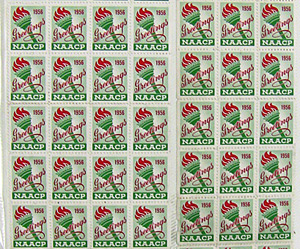I was thumbing through a grouping of papers and documents on African American history when I came across an unused sheet of Christmas stamps. In the center was a lighted torch and at the bottom in crisp white letters was “NAACP.”
The stamps were dated 1956, and they obviously were not actual postage stamps. They were Christmas Seals, words that conjured images from the scourge of tuberculosis more than 50 years ago when the stamps were sold to raise money to combat the illness.
So I was surprised to learn that the NAACP had used a similar fundraising campaign during the early 20th century in its fight for justice and fair play for African Americans.

The sheet was among a group of African American-related items I bought at a special sale at auction. The stamps were stuck to a paper page from one of those old photo albums. The clear covering over the page had left them in pristine condition. There were two separate sheets: 30 stamps on one and 40 on the other.
Christmas Seals grew out of the fight against tuberculosis at the turn of the 20th century in Denmark. They found their way to the United States a couple years later, embraced by the American Red Cross, which created an annual campaign around them featuring original designs by well-known illustrators.
The NAACP’s Christmas seal campaign dates back to 1927. It got started in the home of a West Virginia school teacher, civil rights activist and NAACP member named Memphis Tennessee Garrison. She sold the idea to the national office, and ran it for four years before it got too big for her and the national office assumed responsibility for it in 1930s. I found an appeal from Garrison in the December 1930 Baltimore Afro American newspaper urging people to order them from her.

That first year of sales, according to a 1953 article in the Pittsburgh Courier, netted $291.36, but by 1952, it had swelled to $38,000. The goal for 1953 was $75,000 for the NAACP’s “Fighting Fund for Freedom,” and Lena Horne was the chairwoman of the drive. (Here’s Duke Ellington and Sarah Vaughan in what looks like a publicity photo buying the first stamps in the 1950 campaign.)
The 1953 stamp was designed by Louise E. Jefferson, who had been creating them since 1945 (and would do so for 30 to 40 years).
Jefferson was a graphic artist, illustrator, cartographer and photographer who was friends with artist Augusta Savage and writer Langston Hughes, among other notables of the Harlem Renaissance. She spent many years as art director at Friendship Press, an arm of the National Council of Churches. Jefferson created illustrations for books, match covers, posters, pamphlets, maps and magazines.
One of the items among the auction stash was a 1949 postcard from Friendship Press about purchasing Jefferson’s illustrated map “Americans of Negro Lineage (1946)” for 50 cents a copy.

The NAACP was said to have issued Christmas Seals until 1977, and most of the designs featured the traditional look of the ones I bought. At least two of the illustrations, though, were more political: the 1932 Seal showed a man breaking free of his chains (“NAACP For Justice”) and the 1944 Seal showed an African American soldier (released during the time of the Tuskegee Airmen and the move to desegregate the U.S. military in World War II).
Like the Red Cross Seals, the NAACP’s were also sold for a penny and seemed to have been pretty well accepted. I found several newspaper articles and book references to people selling them – the student branch at Cornell University in 1950 was selling them on campus to raise money for NAACP cases before the U.S. Supreme Court. A woman with the New Orleans branch sold out of her batch in 1935 and sent $20 to the national office for more. In the October 1963 issue of the NAACP’s Crisis magazine, the organization was asking folks to buy Christmas Seals early to support the March on Washington, which had taken place in August.
The NAACP Seals are included in the ethnic section the All Fund Catalog, a guide that lists all of the Red Cross Seals along with those of other U.S. organizations that used them.

Doing some research on prominent WV women and I came across this article. Thank you so much for your work here.
Thanks, Dee. Glad I could help.